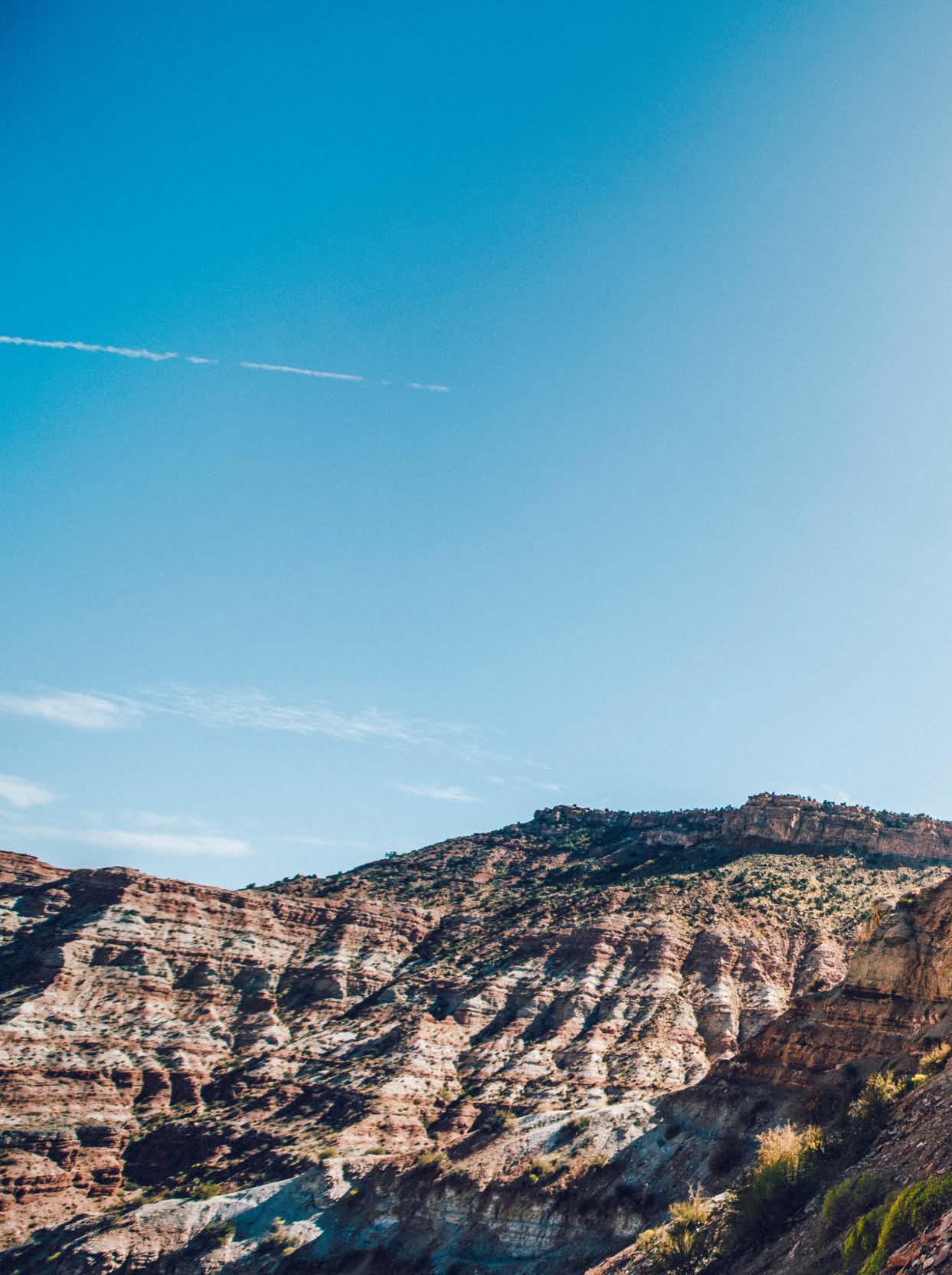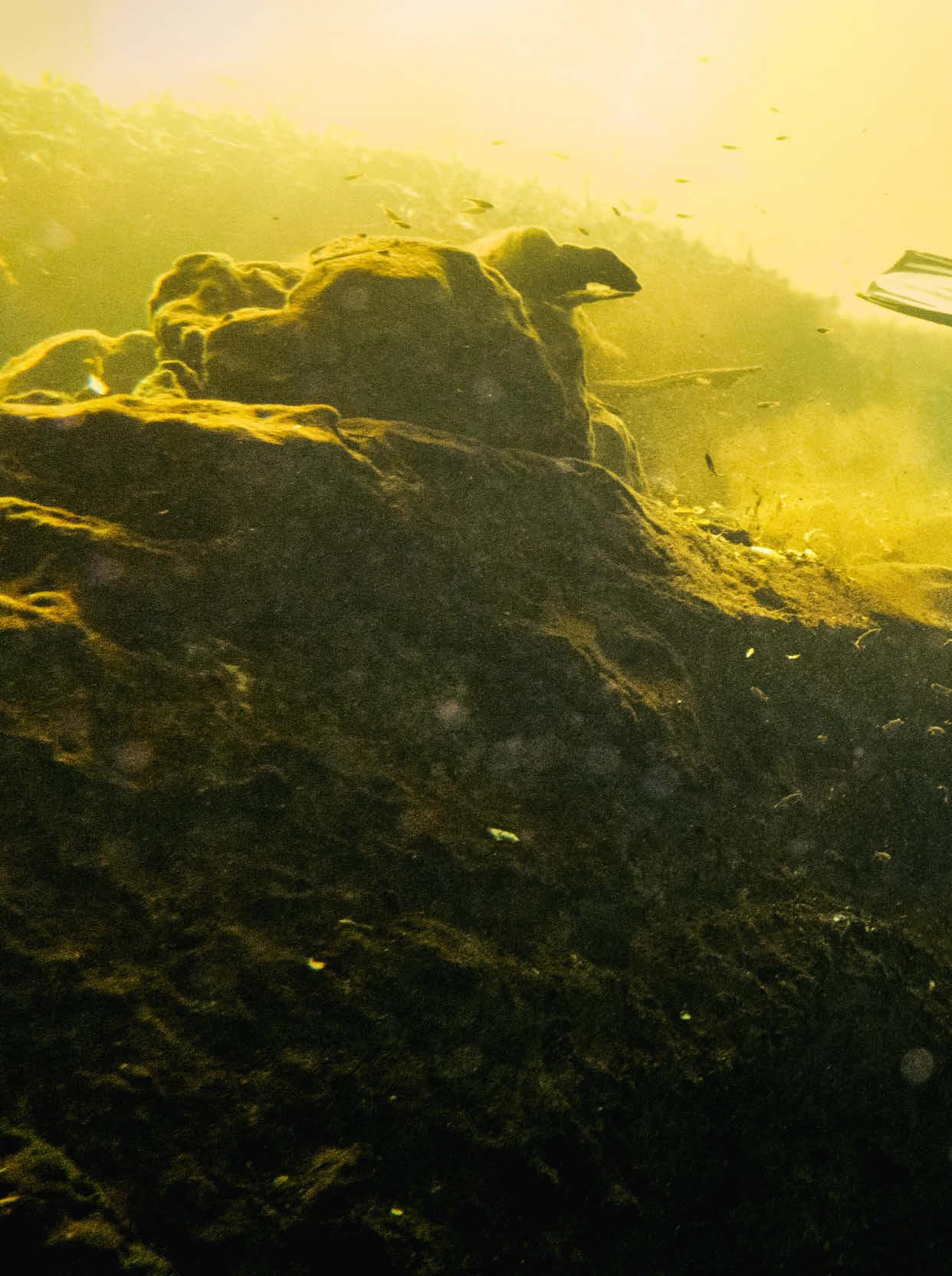
16 minute read
Cave exploration
HIDDEN DEPTHS
Exploring narrow, unmapped underwater caves deep in the Mexican jungle is fraught with danger. But, for two of the world’s most intrepid cave divers, what they discover in these unexplored passageways can be truly life-changing
Words KLAUS THYMANN and RUTH McLEOD Photography KLAUS THYMANN
Thymann enters the water of the cave – coloured yellow near the surface by tannic acid from recent rainfall – with his camera, watching closely for any sign that the underwater housing is leaking. A video light illuminates the path ahead, along with a light on his helmet, which he calls his ‘third hand’


K
laus Thymann is 300m inside an underwater cave in Mexico, 10m below dense jungle, navigating a constricted passageway that’s barely bigger than he is – around 60cm from floor to ceiling. The Danish-born photographer and cave diver is shooting what are likely to be prehistoric human bones, so he has had to adopt a plank position with his arms outstretched, using his lungs to control his level in the water; if any part of him touches any surface, he could destroy these artefacts by disturbing silt that could also leave him with zero visibility. Under this intense pressure, Thymann – who estimates he has spent several hundred hours in caves like these during his career – is the most stressed he’s ever been on a dive. But he knows that if he’s unable to stay calm, he’ll get through his supply of air too quickly and there’s a high chance he could drown.
This is cave diving at its most extreme. Cave exploration is a better description, since most of the routes Thymann and his diving partner Alessandro Reato survey have not yet been mapped, making the pair the first humans in modern history to lay eyes on whatever awaits them around the next dark corner. “Your body screams panic in these situations,” says Thymann. “You are underwater, in darkness, in a confined space, so stress levels are high. But your survival depends on your being calm. You have to develop the skills to subdue that intuitive fear.”
Squeezing expertly through spaces small enough to make most wince, these underwater explorers are willing to go where most can’t or won’t, carrying with them all the equipment they need to avert disaster if something goes wrong – and things often do. “It’s not really a question of if, but when, something will go wrong, meaning you just have to be prepared for it,” says Thymann. “There is no dive buddy. I frequently squeeze through gaps so small I have to tilt my head sideways, and in that position another diver can’t get to you.
“When it comes to kit, we have at least two of almost everything. Two is one, one is none, as we say. Packing and preparation are done with military precision, as even a little thing can be what saves the day. I don’t like risks. I work methodically and don’t deviate from my protocol – that’s how I justify doing this. I plan, I prepare, and then of course I’ve had extensive professional training and
Top left: you can’t see it from the air, but beneath the dense jungle there’s access to the underwater caves. Above: they may be filled with air, but the dive tanks weigh more than 10kg each, meaning they’re ferried to site one by one

Locating the cave
“We start out with our porter Jesus walking in front of the 4x4, chopping at vegetation with his machete, but at some point the road and jungle merge, so we get out and walk. Alex’s Italian arms get excited as he talks, disturbing a hornets’ nest. We run, but still get stung. We’re heading for the GPS coordinates that mark the position of a cenote – our access point to the underwater river system. We find cenotes from our Mayan contacts; from seeing on a map where the water should go; from diving and seeing light above; and from others who have told Alex they’ve found a hole in the jungle.”
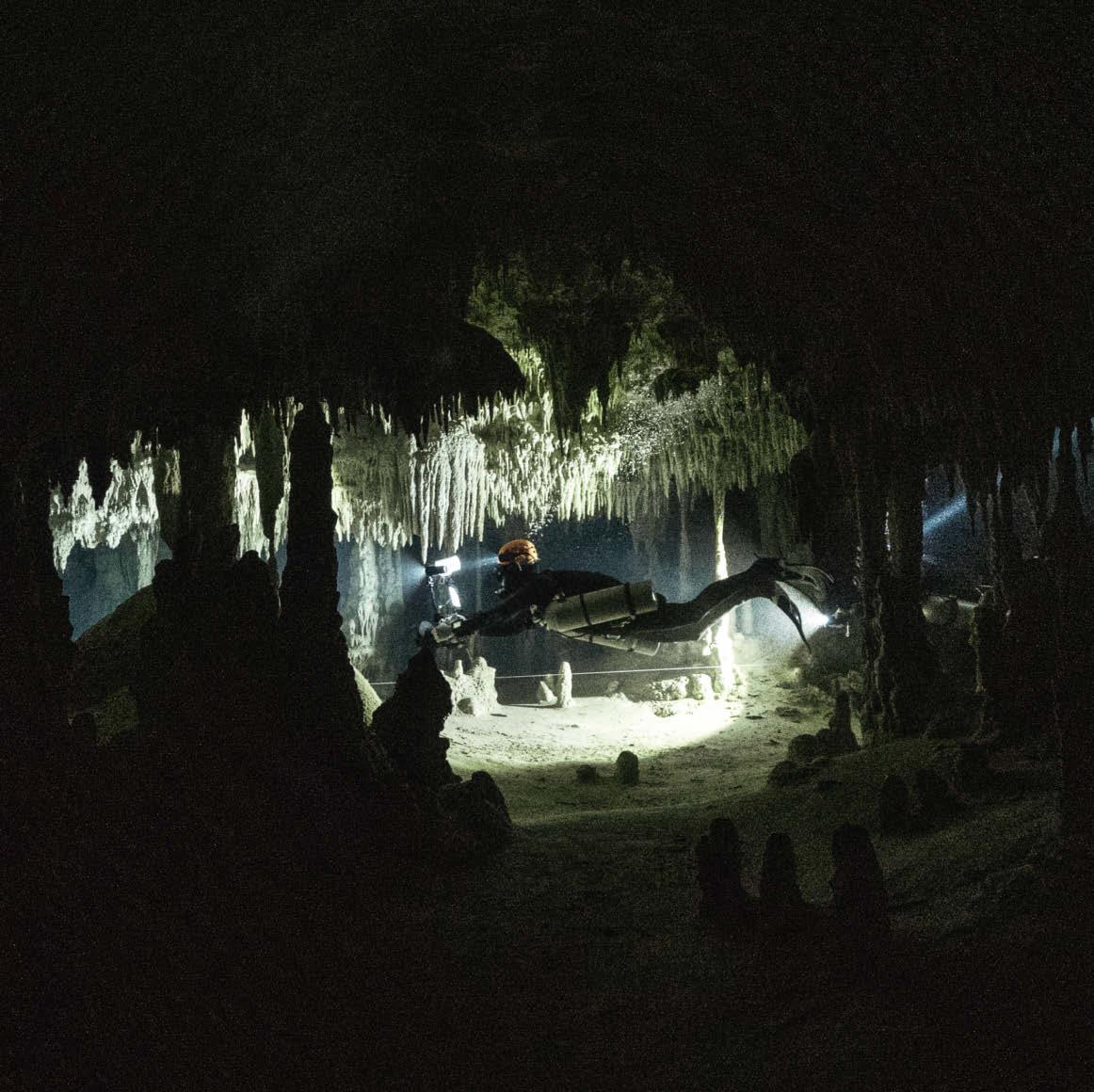
Time travel
“I’ve been cave diving for less than 10 years, but I’ve dived all my life. I remember freediving as a kid, going down with a net to catch octopus in the Mediterranean. I like the challenge of cave diving; I like doing things that are complicated and haven’t been done before. Once I enter the rabbit hole, I just want to go further into it. Diving the underwater rivers feels like entering a time capsule; time doesn’t exist, as there are no outside factors to disturb you – no daylight, no noise, just the sound of your breathing. As we swim through the water, we enter an ancient time, experiencing what no one has for hundreds and thousands of years. However, diving is also very much about time – you have to keep track of it to survive and know your limitations.”
Above left: Thymann – providing the only light in the pitch-black cave – follows the navigational line. The scenery changes constantly: “Two kicks of your fins and you’re somewhere that looks totally different.” Right: Reato readies his mask for diving
have built up experience. It helps that my personality is uber-rational, so I generally solve issues well under pressure – be that on a mountain, inside a glacier, deep underwater, or on the edge of a volcano.”
During a varied career as a journalist, photographer and explorer, London-based Thymann, 46, has trekked new routes to explore the glaciers of Uganda and Congo; was the first person to scuba-dive the world’s clearest lake, New Zealand’s Blue Lake; and has led expeditions to mountains on six continents, all with the aim of furthering knowledge and awareness of the climate crisis. And this mission, he says, is similarly important: “It’s an expedition with a purpose, and that’s what I find interesting. I need that purpose. All of the peaks have been summited, so now you get things being done in multiples – the Three Peaks Challenge or whatever – an artificial goal in order to set a new record. I have a lot of respect for people who are able to do it, but there is no benefit to the world in the 100th person standing on top of a mountain. I’m trying to come back with something that benefits science and helps us make informed choices about how we behave on this planet.”
It was in Mexico – Reato’s current home – that Thymann first met the Italian cave diver and former army cartographer, through friends, in 2016. The pair soon realised they shared a love of mapping and heading off the beaten track; Reato had explored more than 70km of the country’s caves. “I have a similar appetite to Alex in terms of going places where others don’t,” says Thymann. “Even most people who enjoy cave diving won’t crawl down a piece of rope into a hole in the jungle they can barely squeeze through after walking for miles through dense jungle. But we like the parts that are still really wild, and to get to that frontier you must engage with nature differently. Exploration cave-diving certainly isn’t for everyone – our sort of cave diving takes claustrophobia to a new level. With Alex, I feel that I’ve found a partner in crime.”
So, when Reato contacted Thymann last year to tell him about his discovery of this ancient skeleton, the Dane was all in. “In this case, if it wasn’t the bones and the fascinating insights into the past they might give us, it could be for an environmental purpose, like trying to map underground rivers to help protect them,” says Thymann. “The caves here in Mexico are unique; they’re the world’s largest underground system and we need to preserve them – for the habitat, for the reef, for what it provides, and just because it’s a huge archaeological site.”
Using calculations based on historic water levels, they know the bones could

Thymann squeezes through a tight gap, disturbing silt that affects visibility. In spaces this small, he has to crawl. Opposite: Reato leads the dive deep into the cave. “The only thing we leave behind is bubbles,” says Thymann
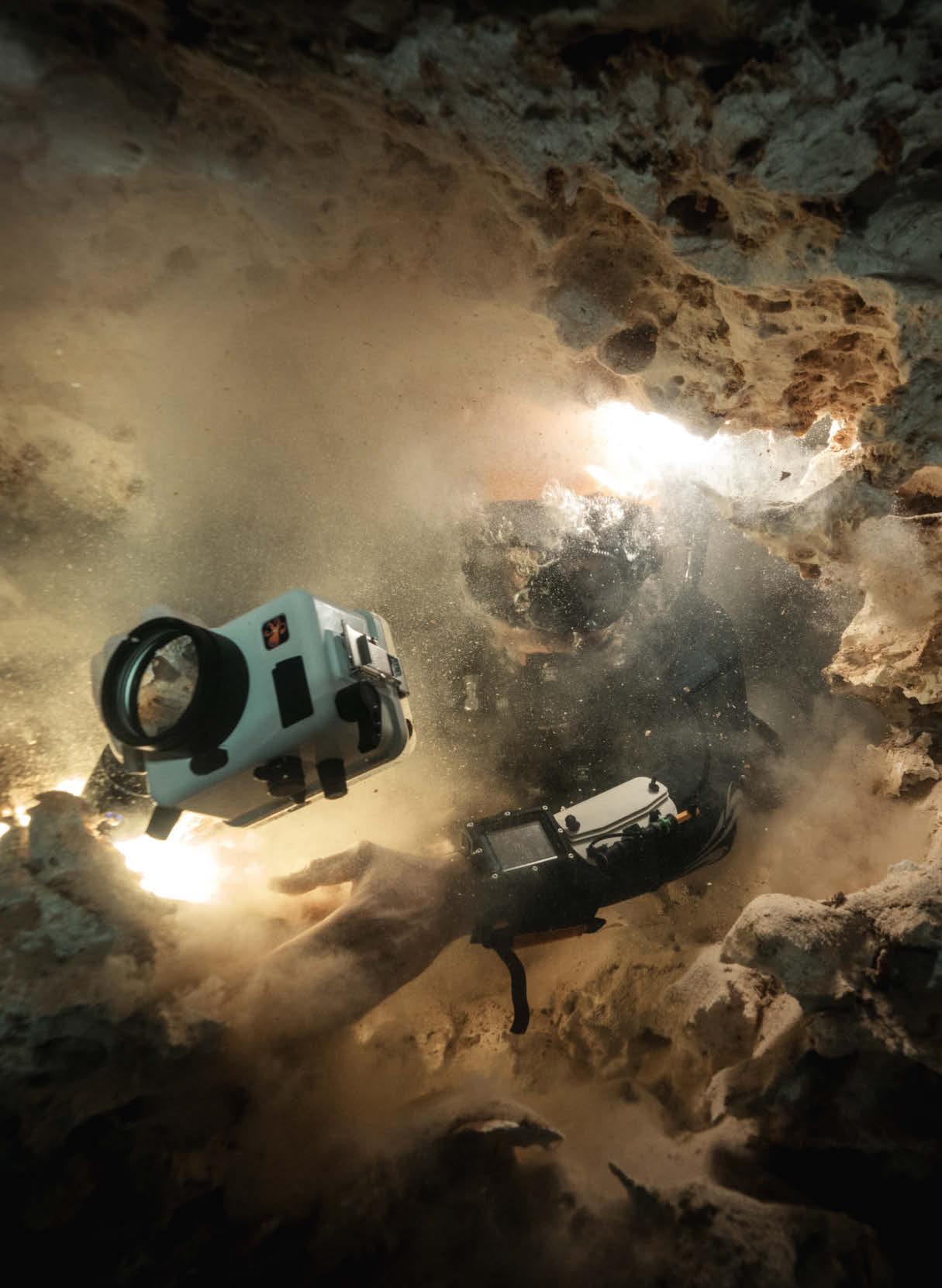
Lining the route
“Exploration of the underwater caves on the Yucatán only began in the 1980s. Back then, mostly American cave-divers would use single-engine aircraft to fly over the jungle, trying to spot cenotes from the air, and would throw something down to mark the spot. Then they’d walk through the jungle to find the marker. Nowadays we have drones and GPS, but no technology has been created that can overcome the complexity of mapping underwater. The main method of navigation is still the same: a continuous line of nylon string from the open water all the way to wherever we’re going in the cave. When caves are explored, the line is left underwater with arrows pointing towards the exit at any intersection. Every cave diver knows how to navigate in total blindness by holding onto the line and feeling the arrows.”
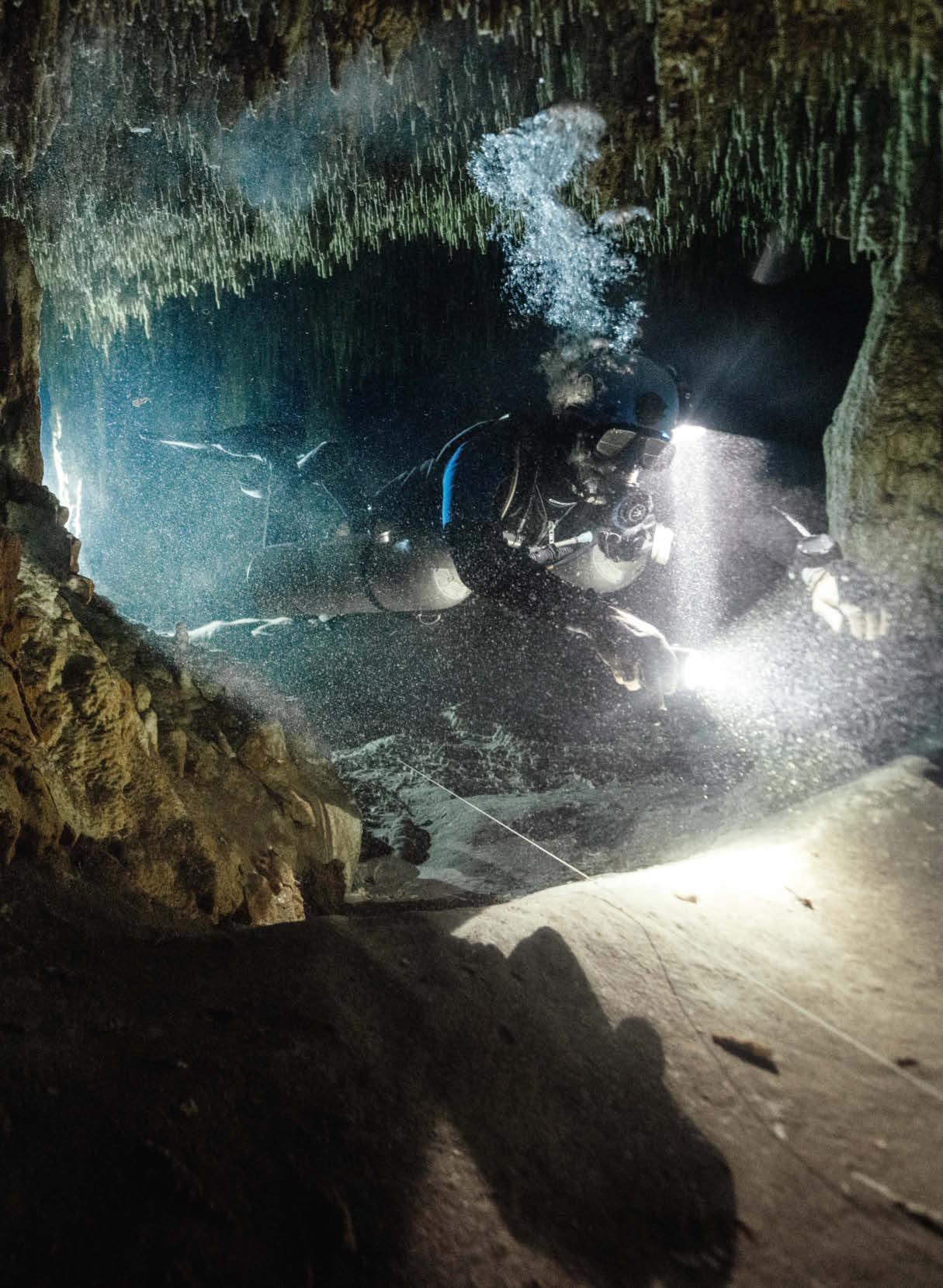
be more than 9,000 years old, which would make them some of the oldest ever discovered in the country. And the race was on to document the find and collect a sample for analysis, guaranteeing the bones official protection from looters who plunder sites such as these.
“We knew we had to keep the exact location of the bones to ourselves,” says Thymann. “What has happened in the past is there’s been an archaeological find, but then you can’t surround it in barbed wire, and when people have come back it’s gone. To me, it’s such a weird thing. I don’t understand it. Even though it’s probably a very small minority doing the looting, they pose a disproportionately big risk. It happens all over the world; there’s a black market for artefacts. So we knew we had to be careful – and quick.”
Thymann doesn’t drink at all for at least a week before a dive. He exercises every day and sticks to a healthy diet – extra pounds do nothing for your ability to inch through cramped spaces. “For weeks, I prepared from my base in Europe. For an expedition, I bring more than 100 items. I keep things in working order, but I still test it all before heading out. Alex sent me a sketch of the area with the bones and we discussed approaches. We have defined roles: Alex leads the exploration, and I document it and create the material the archaeologists and scientists need.”
When Thymann arrived in Tulum to meet Reato and head into the jungle, he was – as always – prepared for anything. But, no matter how many times he ventures into the depths of the Yucatán underwater caves, it never becomes routine. “Before heading into the cave, I felt a mixture of extreme excitement but also disbelief,” Thymann says. “I was thinking, ‘These are prehistoric human bones and this is insanely special.’ There is awe around it. It makes you humble in a way. You’re just looking at a tiny piece of a very big puzzle. And that’s a very healthy way of looking at things sometimes. It reminds you that your little life is not so significant.”
Kit list
Preparation is key, and a mission of this kind requires 44kg of vital equipment
1. Two independent tanks with a regulator and pressure gauge attached 2. Fins. Thymann uses normal fins, which are slightly longer and heavier than cave fins and help counterbalance the weight of his camera 3. Wetsuit. He has a 5mm suit, hood, 3mm vest, and boots 4. Secondary dive light (first back-up), which is attached to his helmet with a bungee cord 5. Helmet, which is customised to hold lights 6. BCD (buoyancy control device) with two bladders – the second is a back-up 7. Primary light, attached to a battery with a cable 8. Video lights 9. Line markers, used for navigation. Thymann’s are bespoke, circular ‘cookie’-shaped markers, so on wellused lines he can feel which are his 10. Third light (second back-up) 11. Dive pouch, which holds tools and spare parts, reels and a spare mask for deeper dives 12. Camera housing with dome and handle 13. Underwater flashes 14. Dive mask 15. Bottom timer, which displays depth and time (back-up to dive computer) 16. Housing for a small compact camera (mainly back-up) 17. Surface marker, which can be inflated at the surface entry point with a line attached or, once submerged, float camera housing to the surface quickly in case of an issue 18. Primary reel 19. Dive computer 20. Wrist slate, used for navigation 21. Bigger slate and pencil (with wrist strap), used for advanced notes
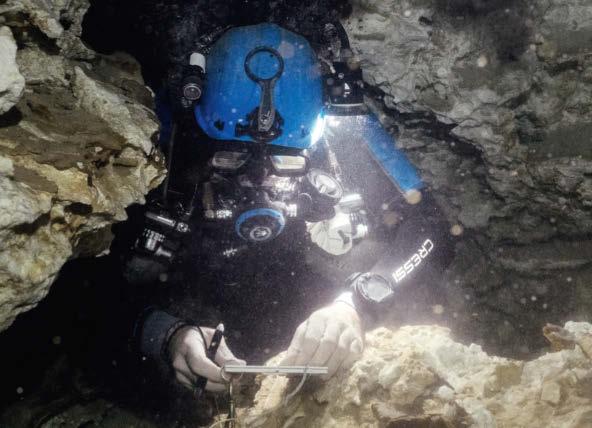
2 3 4 5
9
1 6 7
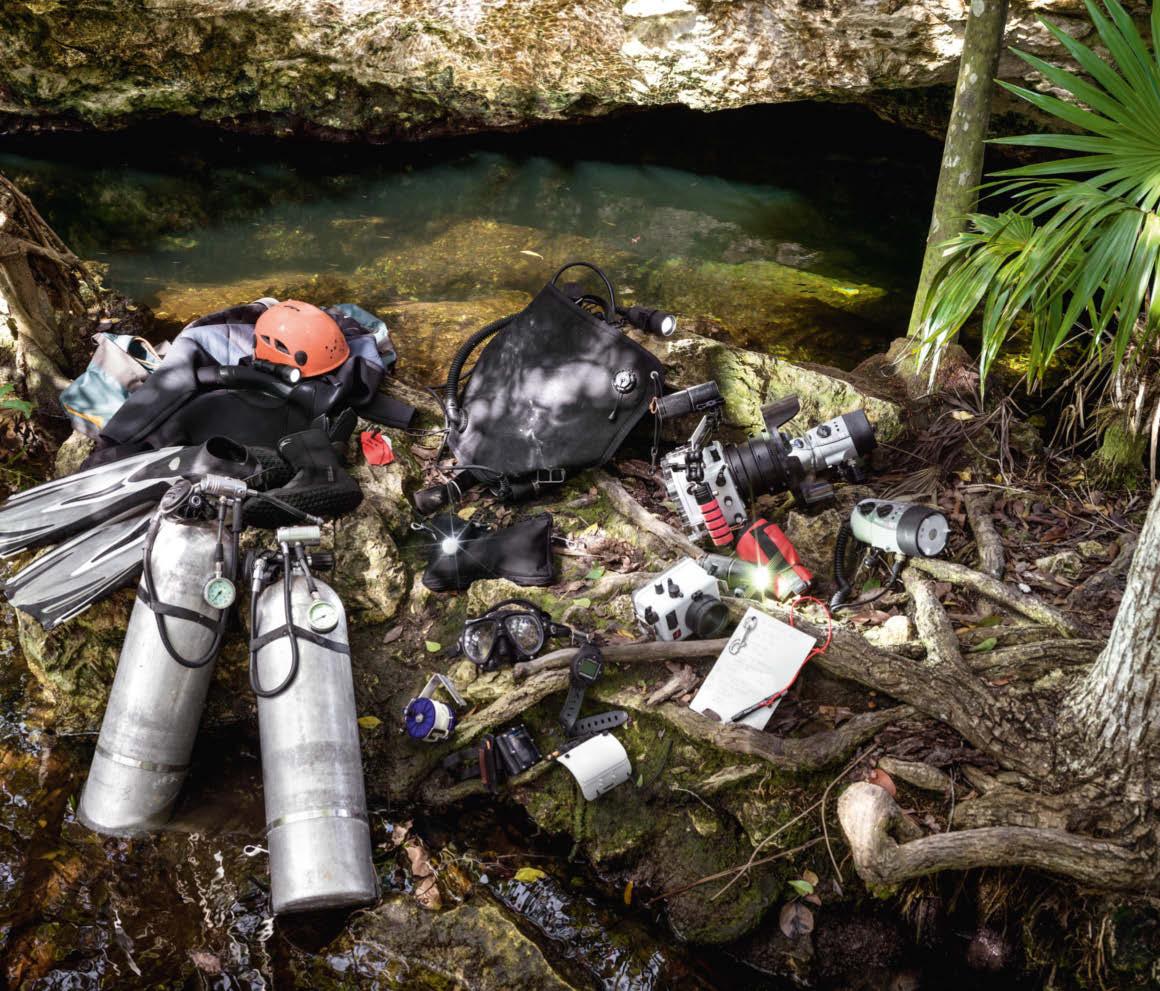
8
10 11
14
18
19 12
15 16
20 17 13
21

Fully equipped
“When cave diving, everything’s complicated. Communication underwater is complicated, because you can’t talk, so you use sign language. But then, a lot of time in caves you can’t see, either, so you communicate with light signals. Then, if we’re doing something that involves a fairly complex task, we use a slate that we can write on with a pencil. Cave diving in itself is taxing; the basics you have to monitor are time, depth, gas consumption, and navigation. Then adding something else complex, like doing photogrammetry [surveying and mapping] or photography underwater, is extremely difficult. I have to know where every piece of kit is, by feel, so I can reach it in zero visibility if I need to, and know how to instantly unclip and untangle it. For instance, my pencil has a bungee cord that sits around my wrist like a bracelet. If I’m writing, that’s a tool I might need for the recalculation of gases, and for navigation too, so that pencil is insanely important. But then I do have a spare pencil in my pouch. And I carry a knife to sharpen it underwater if I need to.”
Slow and steady
“Having swum hundreds of metres into the cave, I’m in an appendix part of the cave, hovering above prehistoric bones. The space is so tight there’s less than an elbow’s length between the dome on my underwater-camera housing and skull parts including loose teeth that lie beneath the fine-grained silt. Any wrong move will disturb this archaeological site and cause damage. It’ll also cause a silt cloud to rise, creating zero visibility, which is a really bad scenario. There’s so little room I can’t even swim, so I’m planking, stretching out my body, arms and legs. I’m being positioned by Alex, who’s holding me by the ankles and manoeuvring me around. To navigate, I signal using my hands – index finger forward and Alex slowly pushes me forward. As I try to remain zen in this cavediving yoga position, Alex hits the top of my leg. We’ve rehearsed this and I know what to do. I release a tiny bit of air from my lungs and descend about 5cm, just enough to avoid a lowhanging part of the cave roof. Every small movement here is a feat in itself. We move a few centimetres at a time, across an imaginary grid, to document everything. I check my pressure gauges constantly to ensure I’m not using too much air and that I can still get out of here. The whole operation takes 70 minutes. I shoot about 500 images of the area where the skull is, which will be put into a photogrammetry model so scientists can navigate the cave on a computer screen.”
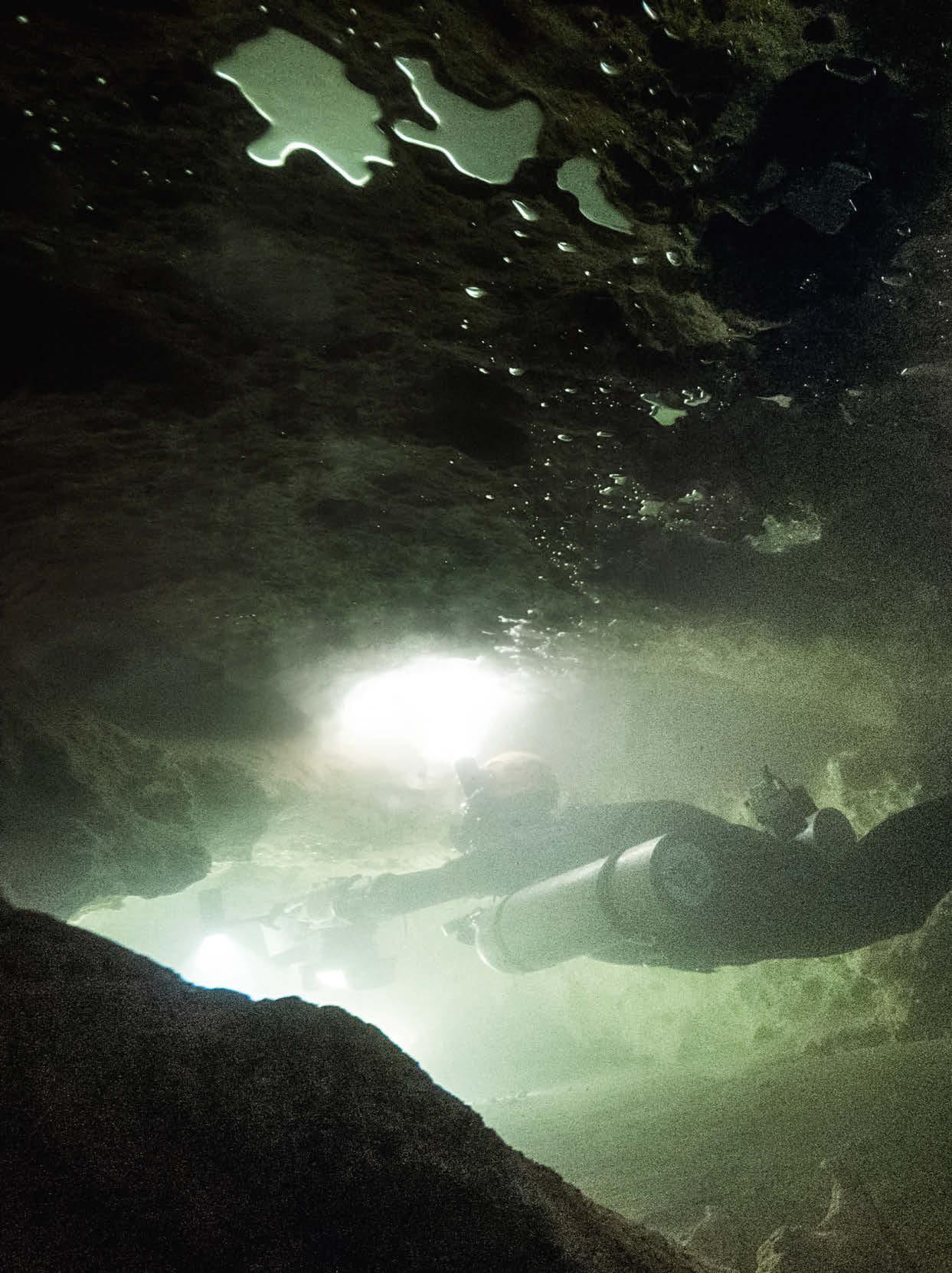
Bubbles created by the divers accumulate and merge at the roof of the cave. Here, it’s essential they don’t come into contact with the porous cast rock that surrounds them; even a small impact will cause damage
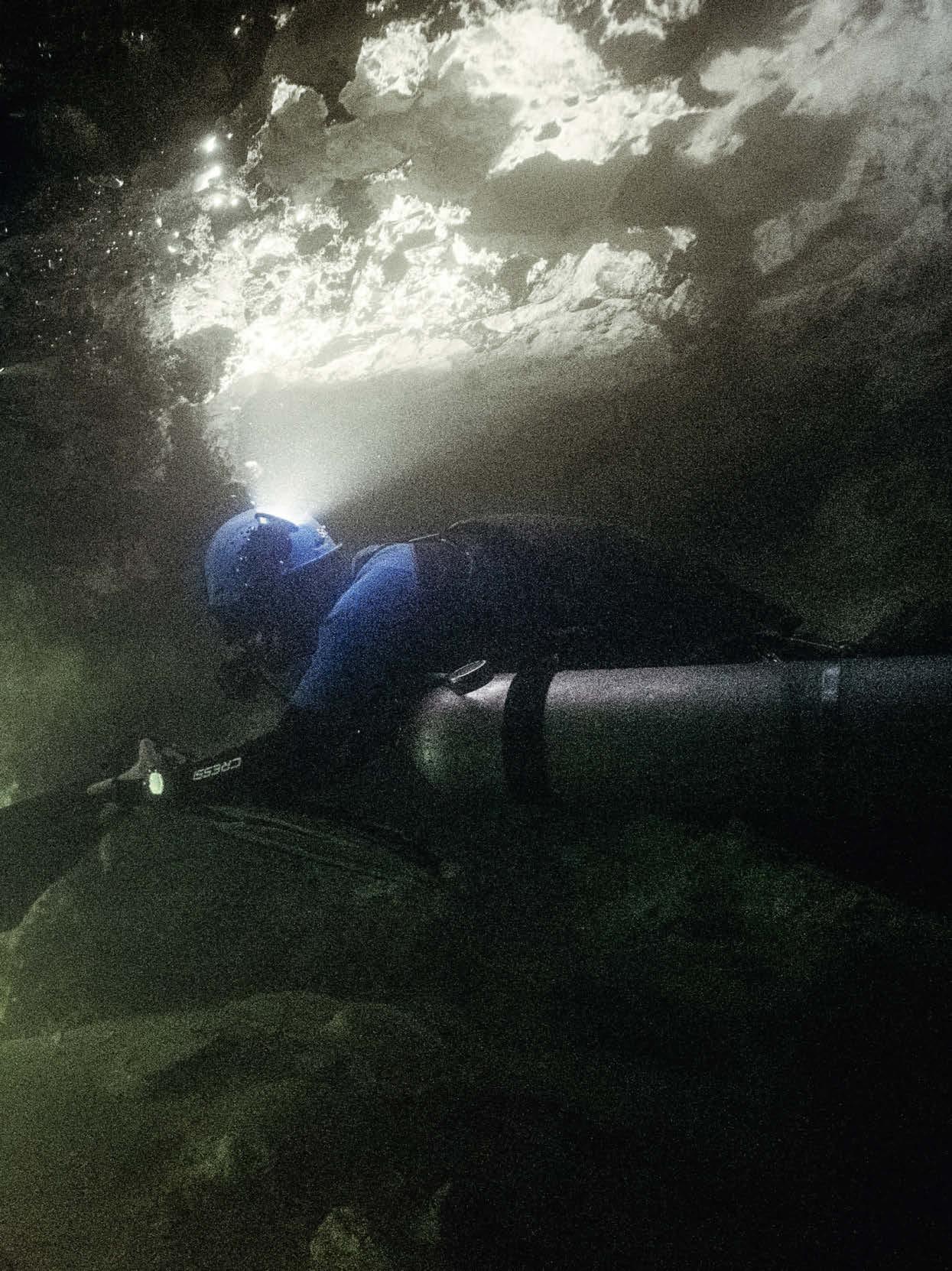
Reato lays down a fresh navigational line from his exploration reel in this unexplored cave and ties it off to a stalagmite
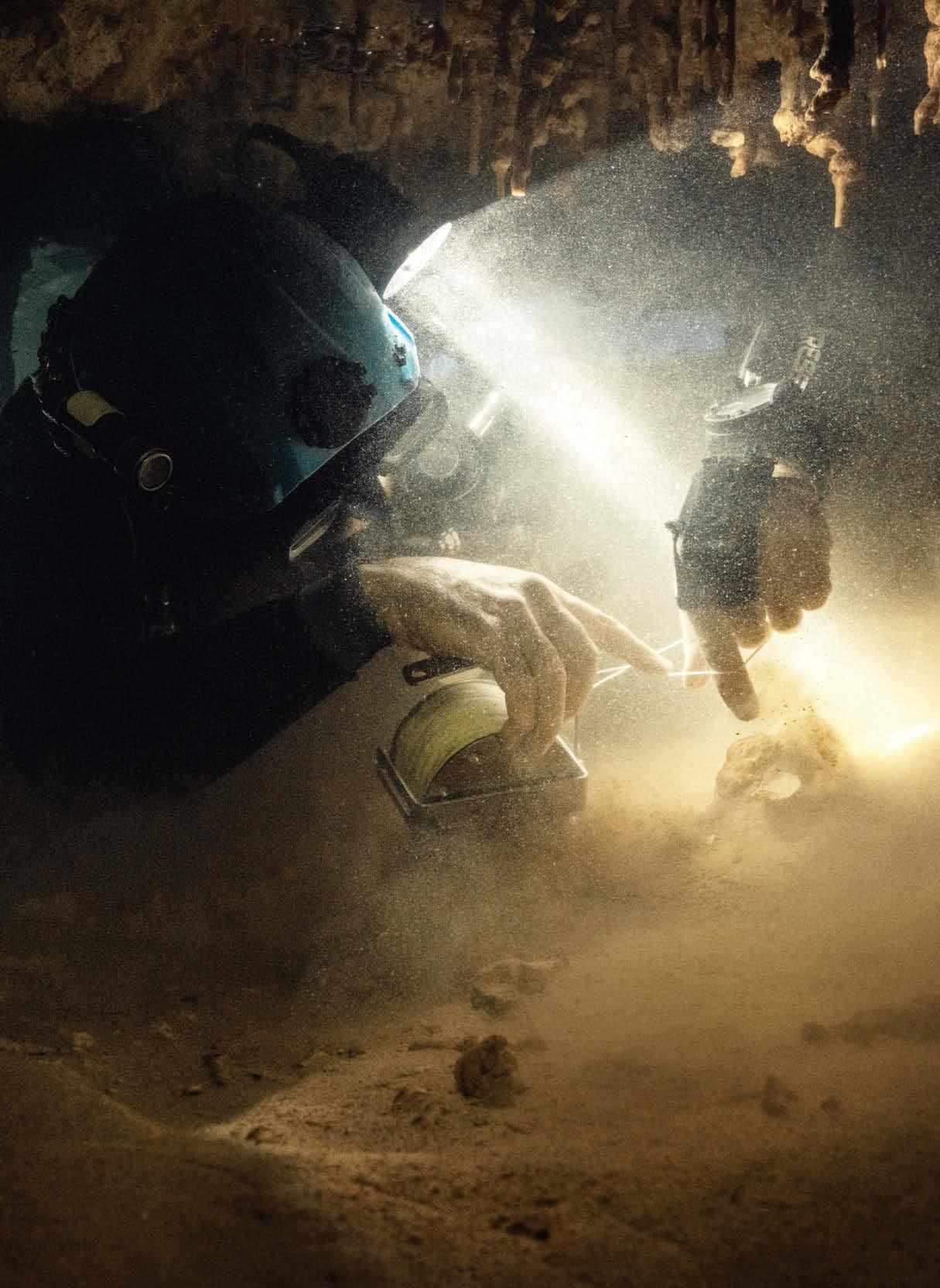
Off the chart
“Mapping is a big part of what I do. Whether it’s mapping glaciers or new trekking routes in Uganda, I try to map out new terrain, both in a conceptual and very straightforwardly practical manner, and these underground river systems are one of the only places on the planet that haven’t been mapped. That makes it very exciting. There are many risks – the equipment can fail, the cave can collapse, you can have a heart attack underwater, or get lost in a cloud of silt – but the reality is that most deaths while cave diving happen due to navigational errors. Cave diving follows a tried-and-tested method of having a string to follow out, but the caves are not simple one-lane roads – they’re more like distorted spider webs. One wrong turn can lead you further away from the open water, and at some point you run out of air.”
Thymann uses UV light to assess damage to the bones. Below: close to an intact jawbone lies a molar with good potential for DNA extraction

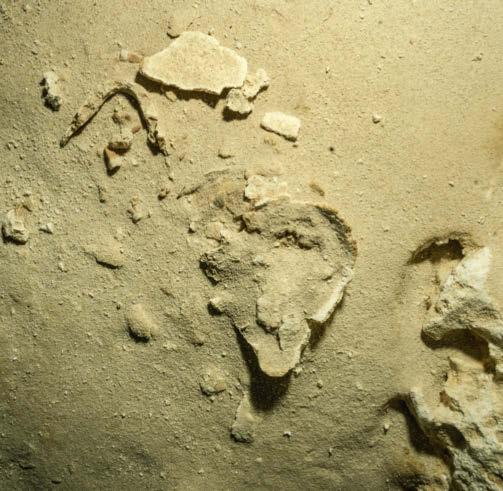
Body of evidence
“There are a lot of indications that this is a prehistoric skeleton. For now, that’s based on the historic water levels and the current water depth. By combining the two measurements, you can see what’s realistic. The depth of the site is 10m, which means that the last time the caves were dry in this area was between 8,000 and 10,000 thousand years ago. And it’s totally unreasonable to think somebody could have died and floated into these caves against the current. So it makes these bones potentially some of the oldest human remains to be found in Mexico. But that will depend on the exact date. The water-level calculations indicate the youngest the bones should be, but of course there’s nothing to say these bones couldn’t have been here for a significant period before the water level rose. For now, having completed this part of the mission, we head out and surface. It’s a success, and we have all the material we need to file permits with the Mexican authorities that allow us to take a sample for analysis. The DNA can reveal fascinating insights into our ancestors, and underline the huge archaeological value of these river systems.”





